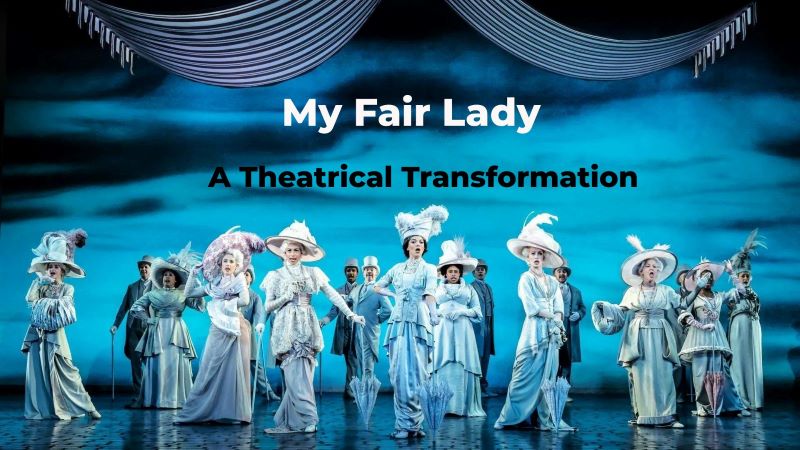Manchester, the vibrant city known for its rich cultural heritage, has recently witnessed a theatrical phenomenon that has left audiences spellbound. My Fair Lady, a classic musical, has graced the stage at the Palace Theatre, captivating hearts and minds alike. In this article, we delve into My Fair Lady Manchester, exploring its history, characters, and the delightful twists that make it bloom like a lovely flower.
The Story Unfolds
At the heart of My Fair Lady Manchester lies the tale of Eliza Doolittle, a spirited Cockney flower seller, and Henry Higgins, a linguistics professor with a penchant for transformation. Higgins takes it upon himself to mold Eliza into his vision of a “proper lady.” But as the story unfolds, we question: Who is truly being transformed? The clash of social classes, the power dynamics, and the blossoming romance create an intricate tapestry that keeps the audience on the edge of their seats.
The Creative Vision
Directed by the acclaimed Bartlett Sher, known for his Tony Award-winning productions, this rendition of My Fair Lady breathes new life into the timeless classic. Sher’s fresh outlook infuses the show with subtle yet powerful elements. Suffragettes march alongside the characters, advocating for women’s rights, while cross-dressing adds an unexpected twist. And then there’s Higgins—complex, flawed, and portrayed in a way that challenges our perceptions.
The Enchanting Score
Frederick Loewe’s ravishing score weaves through the narrative, leaving an indelible mark. The iconic songs resonate with audiences:
- I Could Have Danced All Night: Eliza’s yearning for freedom and joy.
- Get Me to the Church on Time: Alfred P. Doolittle’s exuberant celebration.
- Wouldn’t It Be Loverly: Eliza’s dream of a better life.
- On the Street Where You Live: The magic of newfound love.
- The Rain in Spain: The turning point in Eliza’s transformation.
- I’ve Grown Accustomed to Her Face: Higgins’ internal struggle.
The Stellar Cast
The ensemble cast brings these characters to life:
- Adam Woodyatt as the irreverent Alfred P. Doolittle.
- Lesley Garrett as the steadfast Mrs. Pearce.
- Michael D. Xavier as the enigmatic Henry Higgins.
- Charlotte Kennedy shines as the spirited Eliza Doolittle.
- Heather Jackson portrays Mrs. Higgins with grace.
- John Middleton embodies Colonel Pickering.
- And Tom Liggins adds charm as Freddy Eynsford-Hill.
A Fresh Perspective
This production defies conventions. It invites us to see beyond the surface, to question societal norms, and to find beauty in unexpected places. The suffragettes remind us of the ongoing fight for equality, while Higgins’ transformation forces us to examine our own biases. The laughter, the tears, and the sheer brilliance of the performances make this My Fair Lady a theatrical gem.
Who wrote the book for My Fair Lady?
The book for My Fair Lady was written by Alan Jay Lerner. Lerner, an American playwright and lyricist, collaborated with composer Frederick Loewe to create this timeless musical. The story, inspired by George Bernard Shaw’s 1913 play Pygmalion, revolves around Eliza Doolittle, a Cockney flower girl who undergoes speech lessons from Professor Henry Higgins to transform into a lady. The musical’s success on Broadway and its subsequent revivals have solidified its place in theater history.
Behind the Scenes: The Creative Process
The birth of My Fair Lady involved a remarkable collaboration between Alan Jay Lerner and Frederick Loewe. Their synergy transformed Shaw’s Pygmalion into a musical masterpiece. Dive into the creative process that brought Eliza, Higgins, and the bustling streets of London to life.
Eliza’s Journey: From Flower Girl to Empowered Woman
Eliza Doolittle’s transformation transcends mere speech lessons. Explore her emotional evolution—from the gutters of Covent Garden to the glittering ballrooms of high society. How does her newfound confidence impact her relationships and self-perception?
The Timeless Themes: Love, Identity, and Social Class
Beyond the catchy tunes and witty dialogues, My Fair Lady grapples with universal themes. Love blooms amidst phonetics lessons, challenging societal norms. Henry Higgins, the linguistic maestro, faces his own transformation. Let’s dissect these layers of meaning.
The Iconic Costumes and Set Design
Step into the opulent world of Edwardian England. Eliza’s iconic ball gown, Higgins’ study, and the bustling Covent Garden marketplace—all meticulously crafted. How do these visual elements enhance the storytelling?
Read More: Is Beth Alsbury Really Disabled?
Legacy and Impact
Explore the musical’s journey beyond the stage. Its film adaptation starring Audrey Hepburn and Rex Harrison won hearts worldwide. Discover how My Fair Lady continues to inspire generations of theater enthusiasts.
Fan Theories and Easter Eggs
Every great show harbors hidden gems. Are there subtle nods to Shaw’s original play? Do the raindrops in Spain hold a secret? Let’s unravel the mysteries and discuss fan theories.
The Enchanting Score Revisited
Dive deeper into the melodies that linger long after the curtain falls. Analyze the emotional resonance of each song and its impact on character development.
Manchester’s Love Affair with Theater
Why did My Fair Lady find its home in Manchester? Explore the city’s theater scene, its passionate audience, and the historic venues that breathe life into timeless tales.
Conclusion
As the orchestra swells, the audience rises in applause. My Fair Lady Manchester isn’t just a show; it’s an experience. So, dear reader, whether you’re a seasoned theatergoer or a curious newcomer, let the magic of Eliza’s journey sweep you away. And remember, in the words of Professor Higgins, “The moment I let you go, Eliza, I knew I was saying goodbye to my own creation.”



